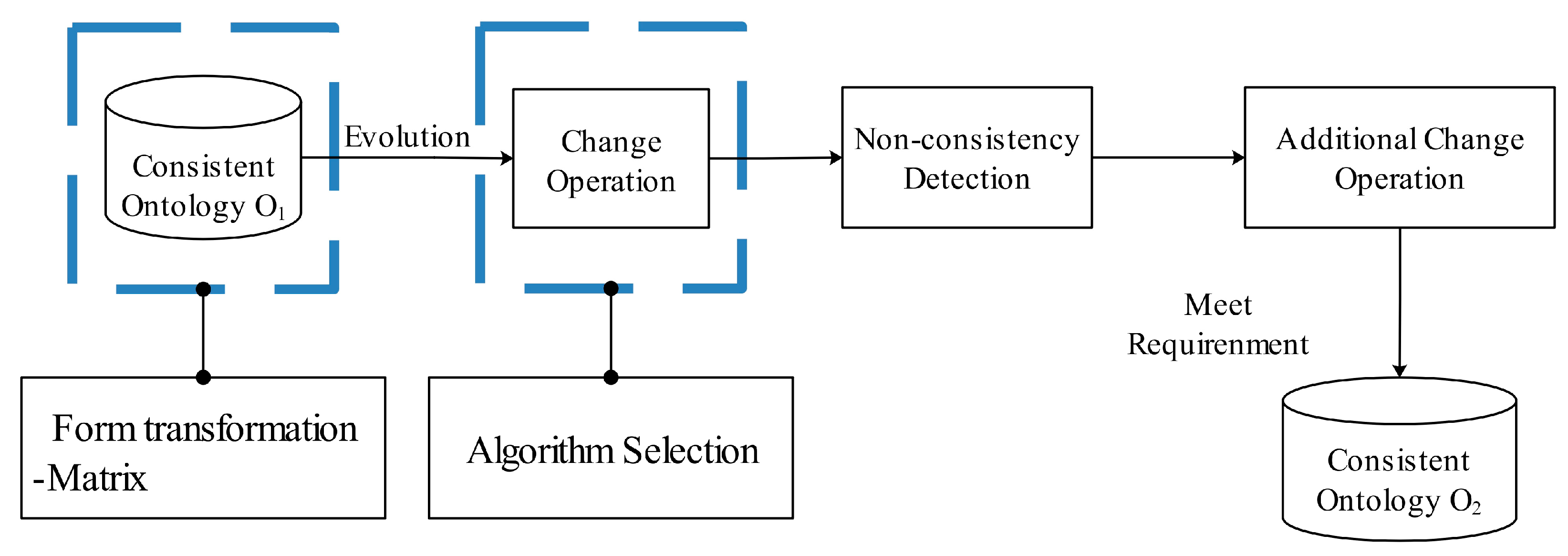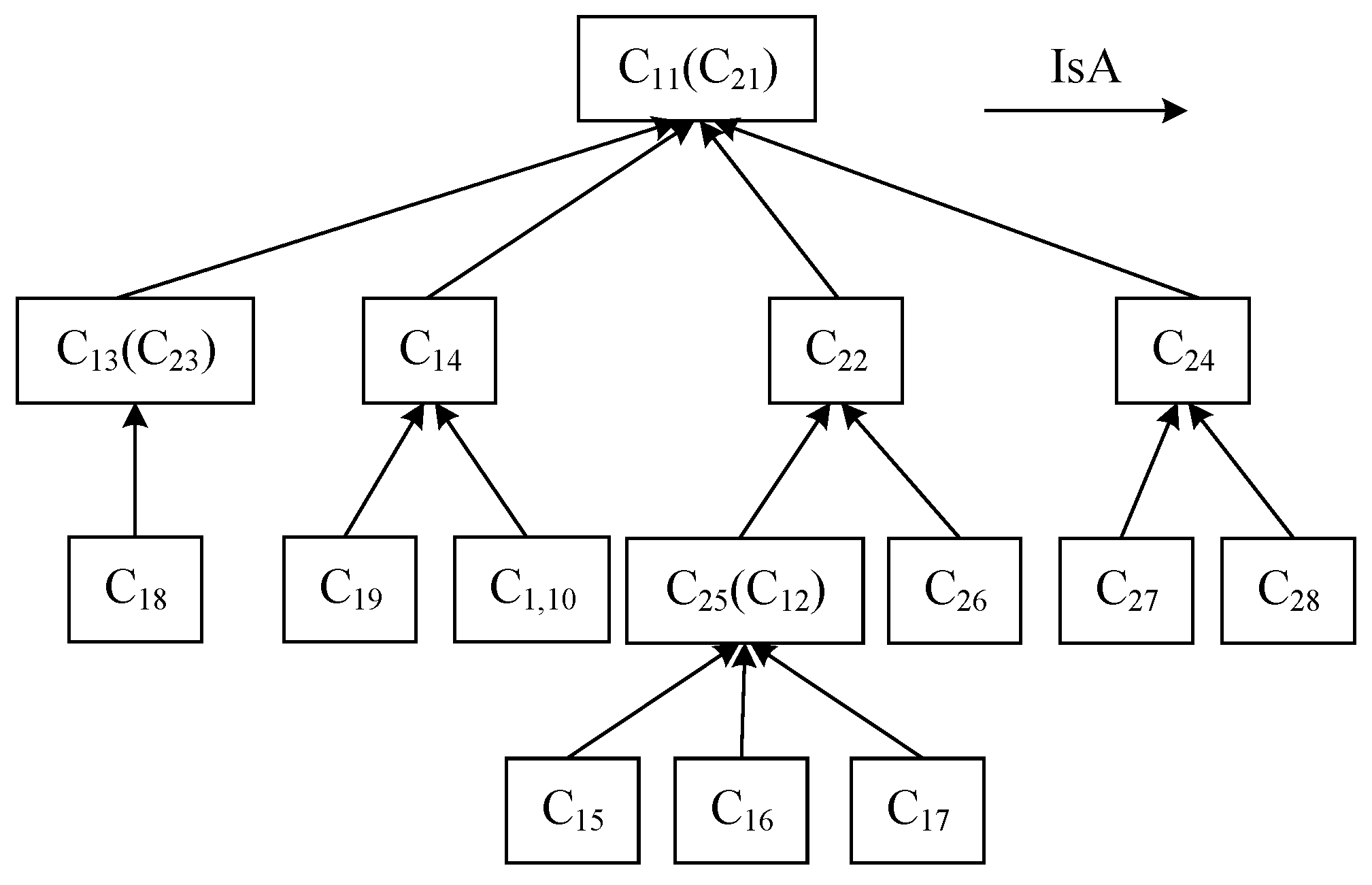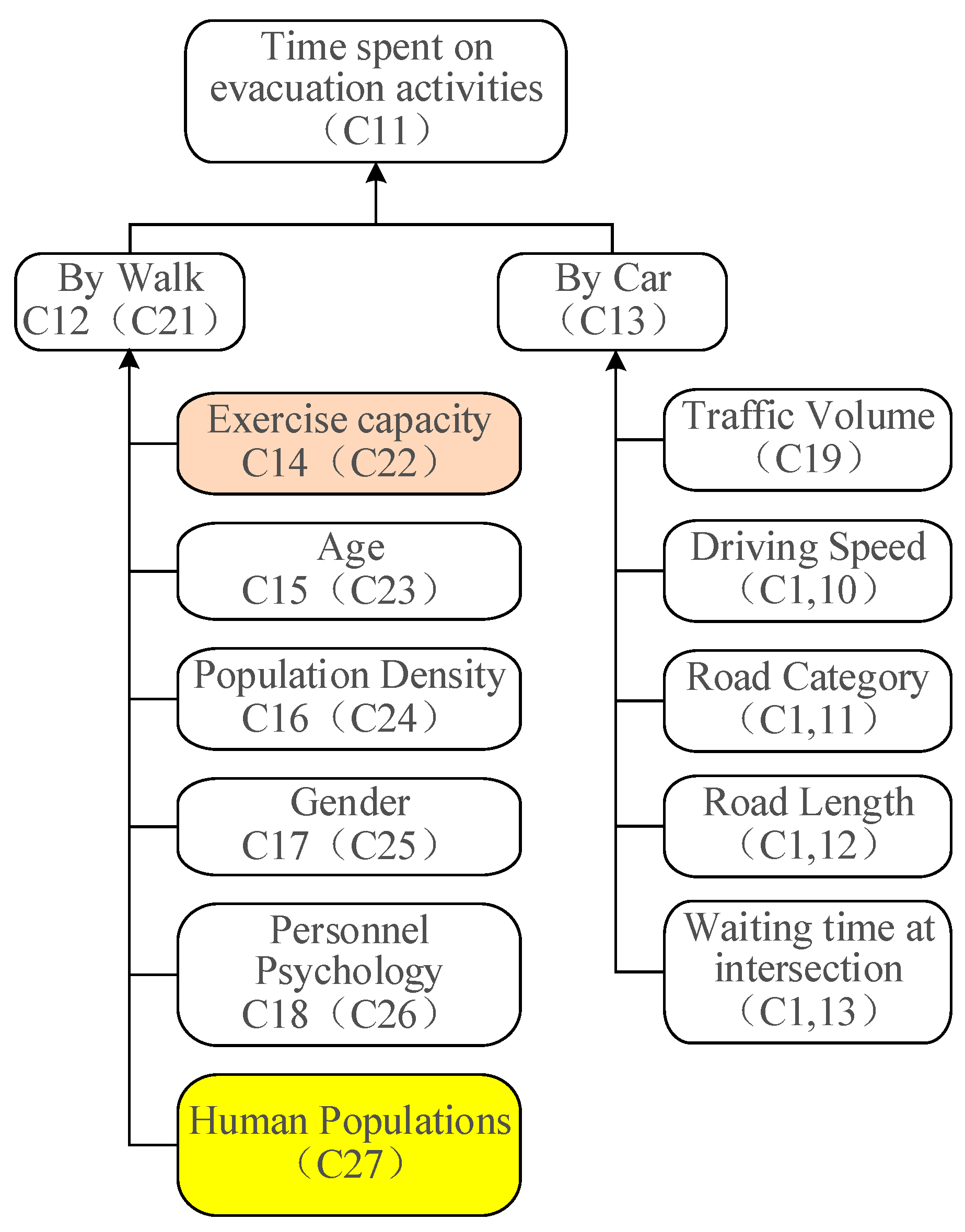Symmetry-Entropy-Constrained Matrix Fusion for Dynamic Dam-Break Emergency Planning
Abstract
1. Introduction
2. Ontology Matrix Algorithm of Dam Break Emergency Plan
2.1. Dam Break Emergency Plan Ontology Structure Matrix
2.2. Ontology Matrix Fusion Model of Dam-Break Emergency Plan
2.3. Ontology Matrix Correlation Operations
2.4. Ontology Fusion Algorithm with Symmetry Entropy Constraints
2.5. Dam-Break Emergency Plan Domain Ontology Fusion Experiment
| Algorithm 1: When s = 0, the fusion algorithm is called the Add algorithm, and the specific steps are as follows: |
| is a new conceptual set, where c30 is the subconcept of all concepts in C1 and C2 on domain E; from the new concept set; Step 3: Obtain the structure matrices F1 and F2 of the two ontology to be fused by matrix operation; Step 4: From the operation can be derived ; , all concepts of c3i, i = 0, 1, 2, …, m + n. Step 6: Based on this, a new ontology after fusion can be constructed. |
| Algorithm 2: When s > 0, the fusion algorithm is called the Merge algorithm, and the specific steps are as follows: |
| Step 1: Based on the concept set of one of the ontologies, all the concepts of C1 and C2 are combined into a new concept set, denoted as Cnew, and only one is taken for the same concept. Step 2: Construct a new concept vector as from the new concept set; Step 3: Obtain the structure matrices F1 and F2 of the two ontologies to be fused by matrix operation; Step 4: Fnew can be derived from the previous algorithm; Step 5: From and , all concepts of ci, i = 0, 1, 2, …, m + n − s. Step 6: Based on this, a new ontology after fusion can be constructed. |
3. Case Studies of Dam-Break Emergency Scenarios
3.1. Scenario Setting
3.2. Analysis
4. Discussion
4.1. Symmetry-Embedded Matrix Fusion for Ontology Evolution
- (1)
- Direct sum symmetry: This operation preserves the block-diagonal structure of source ontology matrices, maintaining their intrinsic hierarchical symmetry. Mathematically, this mirrors the invariant subspaces in group theory, where the direct sum operation satisfies closure and associativity, ensuring structural coherence during fusion. For instance, when s = 0, the fused matrix Fnew = F1 ⊕ F2 retains the independence of F1 and F2, analogous to the decomposition of a symmetry group into irreducible representations.
- (2)
- Hadamard product symmetry: The element-wise multiplication Fnew = F1 ⊗ F2 enforces coordinated interactions between overlapping concepts, ensuring semantic alignment at the finest granularity. This operation exemplifies pointwise symmetry, akin to tensor contractions in symmetric manifolds.
4.2. Case-Driven Validation of Symmetry Constraints
5. Conclusions
- (1)
- Symmetry-Optimized Ontology Fusion: The algorithm dynamically integrates disaster ontologies through symmetric matrix operations (⊕, ⊙), preserving hierarchical-logical symmetry while resolving spatiotemporal asymmetries in disaster propagation and resource allocation. By framing uncertainty as high-dimensional symmetry optimization, it enables real-time emergency plan adaptation with structural-semantic consistency, effectively mitigating nonlinear risks in dam-break scenarios through dynamic equilibrium.
- (2)
- Symmetry-Entropy as a Critical Metric: The proposed Ssym metric quantifies structural asymmetry introduced during ontology fusion. Experimental results confirm that dynamic adjustments increase entropy, but shared concepts (s > 0) mitigate this growth, offering a pathway to balance adaptability and stability.
Author Contributions
Funding
Data Availability Statement
Acknowledgments
Conflicts of Interest
References
- Ministry of Water Resources of the People’s Republic of China. 2023 National Statistical Bulletin on Water Conservancy Development; China Water & Power Press: Beijing, China, 2023. [Google Scholar]
- Li, L.; Cai, Y.B.; Sheng, J.B. Dam safety and risk management in China and its strategic consideration. Chin. J. Geotech. Eng. 2008, 30, 1581–1587. [Google Scholar]
- Zhang, J.Y.; Sheng, J.B.; Cai, Y.B.; Li, Y. Key technologies of dam safety guarantee. Water Resour. Hydropower Eng. 2015, 46, 1–10. [Google Scholar]
- Sheng, J.B.; Li, D.D.; Cai, Q.; Peng, X.H. Research progress on key technologies of dam risk assessment and management. Sci. China Technol. Sci. 2018, 48, 1057–1067. [Google Scholar]
- Sun, J.H. Reservoir dam safety management achievements and challenges in China. China Water Resour. 2018, 20, 1–6. [Google Scholar]
- Clark-Ginsberg, A.; Easton-Calabria, L.C.; Patel, S.S.; Balagna, J.; Payne, L.A. When disaster management agencies create disaster risk: A case study of the US’s Federal Emergency Management Agency. Disaster Prev. Manag. Int. J. 2021, 30, 447–461. [Google Scholar] [CrossRef]
- Sadiq, A.A.; Tyler, J.; Noonan, D.S.; Norton, R.K.; Cunniff, S.E.; Czajkowski, J. Review of the federal emergency management agency’s community rating system program. Nat. Hazards Rev. 2020, 21, 03119001. [Google Scholar] [CrossRef]
- Franzese, O.; Lascurain, M.B.; Capps, G.J. Federal Emergency Management Agency Mobile Housing Unit Running Gear Testing; (No. ORNL/TM-2019/1294); Oak Ridge National Laboratory: Oak Ridge, TN, USA, 2019. [Google Scholar]
- Wu, D.M. Inspiration from the US Federal Volunteer Program and the ‘Great Emergency’ National Force Mobilization. China Saf. Prod. 2020, 15, 60–61. [Google Scholar]
- Li, G.H. Federal Emergency Management Agency. Fire Sci. Technol. 2019, 38, 632. [Google Scholar]
- Li, W.; Cai, G.H. The enlightenment of the US emergency plan system to China. Secur. Sci. 2013, 11, 17–20. [Google Scholar]
- Ren, M.; Yang, F. Research on Emergency Plan Ontology Model. Adv. Mater. Res. 2012, 4, 1288–1292. [Google Scholar] [CrossRef]
- Liu, J.; Li, K. Design and Implementation of Computer Aided Equipment Management Information System. Comput.-Aided Des. Appl. 2020, 18, 155–164. [Google Scholar] [CrossRef]
- Takahashi, T.; Kubo, T.; Mori, K. The Position and Roles of Occupational Health and Safety Functions in the UK Risk Management System. J. UOEH. 2018, 40, 201–208. [Google Scholar] [CrossRef] [PubMed]
- Song, X.W. Community building in emergency management system in the UK. J. Public Adm. Res. 2013, 1, 53–55. [Google Scholar]
- Shao, Y.; Umer, I.B. Crisis prevention information system in Germany. Inf. Constr. 2005, 8, 46–48. [Google Scholar]
- Dickinson, A.; Joos, S. Barriers to Integration of Primary Care into Emergency Care: Experiences in Germany. Int. J. Integr. Care 2021, 21, 11. [Google Scholar] [CrossRef]
- Zhao, T. Research on Intelligent Management and Application System Construction of Emergency Response Plan. Master’s Thesis, Nanjing University of Posts and Telecommunications, Nanjing, China, 2014. [Google Scholar]
- Yang, S.J.; Zhu, X.F.; Tan, B. Research on capability evaluation criteria of mine emergency rescue team based on cloud model. Coal Mine Saf. 2021, 52, 250–255. [Google Scholar]
- Zhao, K.G.; Li, Y.P. Analysis and development of coal resource security in China. Coal Eng. 2018, 50, 185–189. [Google Scholar]
- Zhang, C.; Pei, Y.Q.; Qiu, H. Development status and trend of digital emergency plan technology at China. China Saf. Sci. Technol. 2010, 5, 156–160. [Google Scholar]
- Ma, L. Research on digital emergency plan system for coal mine on ontology. J. Xi’an Univ. Sci. Technol. 2014, 34, 216–223. [Google Scholar]
- Lee, Y.Y.; Ke, H.; Yen, T.Y.; Huang, H.H.; Chen, H.H. Combining and learning word embedding with WordNet for semantic relatedness and similarity measurement. J. Assoc. Inf. Sci. Technol. 2020, 71, 657–670. [Google Scholar] [CrossRef]
- Lhioui, C.; Zouaghi, A.; Zrigui, M. A rule-based semantic frame annotation of arabic speech turns for automatic dialogue analysis. Procedia Comput. Sci. 2017, 117, 46–54. [Google Scholar] [CrossRef]
- Malik, S.; Jain, S. Sup Ont: An upper ontology. Int. J. Web-Based Learn. Teach. Technol. 2021, 16, 79–99. [Google Scholar]
- Xiao, J. Research on Mathematical Knowledge Management of Petrochemical Enterprises Based on Ontology. Ph.D. Thesis, Zhejiang University, Hangzhou, China, 2015. [Google Scholar]
- Fu, J.L.; Liu, W.L.; Zheng, X.L.; Fan, Y.; Wang, S.Y. Research on Main Characteristics of “East Turkistan” Activities Based on Text Mining and Network Analysis. Acta Autom. Sin. 2014, 11, 2456–2468. [Google Scholar]
- Zhang, G.L.; Wang, Y.; Wang, Z.N.; Lin, C.L. Research on robot integration framework and application for loosely coupled services. J. Chin. Comput. Syst. 2018, 39, 651–656. [Google Scholar]
- Zhang, L.; Xu, W.; Zhang, F.; Wei, W.; Zhou, M.; Zhang, X. Dam-break-like tsunami waves flow over partially damaged trapezoidal obstacles. Ocean Eng. 2025, 326, 120805. [Google Scholar] [CrossRef]
- Esteban, M.A.; Alpañés, J.D.L.J.; Castillo, P.; Karabulut, M. Dynamic Analysis of the Almagrera Tailings Dam with Dry Closure Condition. Sustainability 2024, 16, 1607. [Google Scholar] [CrossRef]
- Wang, B.Z. Research on Ontology Fusion Algorithm Based on Matrix Form Operation. Master’s Thesis, China Agricultural University, Beijing, China, 2007. [Google Scholar]
- Shannon, C.E. A mathematical theory of communication. Bell Syst. Tech. J. 1948, 27, 379–423. [Google Scholar] [CrossRef]
- Golub, G.H.; Van Loan, C.F. Matrix Computations, 4th ed.; Johns Hopkins University Press: Baltimore, MD, USA, 2013. [Google Scholar]
- Boyd, S.P.; Vandenberghe, L. Convex Optimization; Cambridge University Press: Cambridge, UK, 2004. [Google Scholar]











| Case | Source Ontology Ssym(F1) | Source Ontology Ssym(F2) | Fused Ontology Ssym(Fnew) |
|---|---|---|---|
| S = 1 | 1.301 | 1.255 | 1.45 |
| S = 3 | 1.301 | 1.255 | 1.35 |
| Grading Index | Situation Description |
|---|---|
| Road damage | Road traffic is in good condition |
| Area and scope of influence | Some areas such as XX City, YY County, ZZ County, etc |
| Infrastructure damage | Municipal highways, transmission (water) lines, oil and gas pipelines and enterprises |
| Number of casualties | 7 persons |
| Direct economic loss | 37 million yuan |
| Affected population | 350,000 people living behind the dam and downstream |
| Natural and Cultural Landscapes | Provincial and Municipal Natural and Cultural Landscapes |
| Animal and plant habitats | National Secondary and Tertiary Protection of Animals and Plants and Their Living Environment |
| River movement pattern | Serious damage to small rivers |
| Urban | Town |
| Expected recovery period | 90 days |
| Evacuation efficiency | There are significant differences in the walking evacuation capabilities of different groups of people, and the actual evacuation time has an average deviation of 20% compared with the preset model. For example, the evacuation speed of the elderly and children is 30% slower than that of the preset model, while the evacuation speed of young and middle-aged people is basically consistent with the model prediction. |
Disclaimer/Publisher’s Note: The statements, opinions and data contained in all publications are solely those of the individual author(s) and contributor(s) and not of MDPI and/or the editor(s). MDPI and/or the editor(s) disclaim responsibility for any injury to people or property resulting from any ideas, methods, instructions or products referred to in the content. |
© 2025 by the authors. Licensee MDPI, Basel, Switzerland. This article is an open access article distributed under the terms and conditions of the Creative Commons Attribution (CC BY) license (https://creativecommons.org/licenses/by/4.0/).
Share and Cite
Liu, S.; Yang, D.; Hu, H.; Wang, J. Symmetry-Entropy-Constrained Matrix Fusion for Dynamic Dam-Break Emergency Planning. Symmetry 2025, 17, 792. https://doi.org/10.3390/sym17050792
Liu S, Yang D, Hu H, Wang J. Symmetry-Entropy-Constrained Matrix Fusion for Dynamic Dam-Break Emergency Planning. Symmetry. 2025; 17(5):792. https://doi.org/10.3390/sym17050792
Chicago/Turabian StyleLiu, Shuai, Dewei Yang, Hao Hu, and Junping Wang. 2025. "Symmetry-Entropy-Constrained Matrix Fusion for Dynamic Dam-Break Emergency Planning" Symmetry 17, no. 5: 792. https://doi.org/10.3390/sym17050792
APA StyleLiu, S., Yang, D., Hu, H., & Wang, J. (2025). Symmetry-Entropy-Constrained Matrix Fusion for Dynamic Dam-Break Emergency Planning. Symmetry, 17(5), 792. https://doi.org/10.3390/sym17050792





